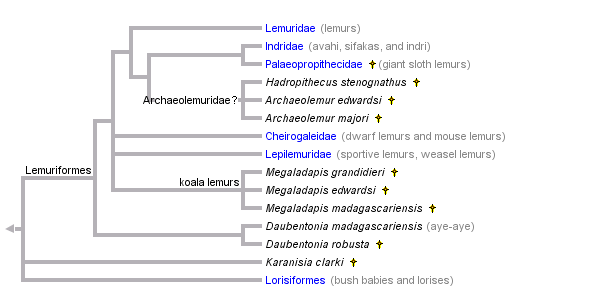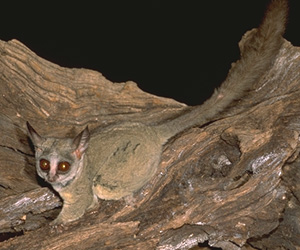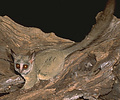Strepsirrhini



This tree diagram shows the relationships between several groups of organisms.
The root of the current tree connects the organisms featured in this tree to their containing group and the rest of the Tree of Life. The basal branching point in the tree represents the ancestor of the other groups in the tree. This ancestor diversified over time into several descendent subgroups, which are represented as internal nodes and terminal taxa to the right.

You can click on the root to travel down the Tree of Life all the way to the root of all Life, and you can click on the names of descendent subgroups to travel up the Tree of Life all the way to individual species.
For more information on ToL tree formatting, please see Interpreting the Tree or Classification. To learn more about phylogenetic trees, please visit our Phylogenetic Biology pages.
close boxReferences
DelPero, M., S. Crovella, P. Cervella, G. Ardito and Y. Rumpler. 1995. Phylogenetic relationships among the Malagasy lemurs as revealed by mitochondrial DNA sequence analysis. Primates 36 (3):431-440.
DelPero, M., J. C. Masters, P. Cervella, S. Crovella, G. Ardito and Y. Rumpler. 2001. Phylogenetic relationships among the Malagasy lemuriforms (Primates: Strepsirrhini) as indicated by mitochondrial sequence data from the 12S rRNA gene. Zool. J. Linnean Soc. 132:83-103.
Godfrey, L. R., W. L. Jungers, K. E. Reed, E. L. Simons, and P. S. Chatrath. 1997. Subfossil lemurs: inferences about past and present primate communities in Madagascar. Pages 218-256 in S. Goodman and B. Patterson (eds.) Natural and Human-Induced Change in Madagascar. Smithsonian Institution Press, Washington DC.
Godfrey, L. R. and W. L. Jungers. 2002. Quaternary fossil lemurs. Pages 97?121 in The Primate Fossil Record. W. C. Hartwig, ed. Cambridge Univ. Press, Cambridge, U.K.
Karanth, K. P., T. Delefosse, B. Rakotosamimanana, T. J. Parsons, and A. D. Yoder. 2005. Ancient DNA from giant extinct lemurs confirms single origin of Malagasy primates. Proceedings of the National Academy of Sciences (USA) 102(14):5090-5095.
King, S. J., L. R. Godfrey, and E. L. Simons. 2001. Adaptive and phylogenetic significance of ontogenetic sequences in Archaeolemur, subfossil lemur from Madagascar. Journal of Human Evolution 41(6):545-576.
Montagnona, D., B. Ravaoarimanana, B. Rakotosamimanana, and Y. Rumpler. 2001. Ancient DNA from Megaladapis edwardsi (Malagasy Subfossil): Preliminary Results Using Partial Cytochrome b Sequence. Folia Primatologica 72:30?32.
Porter, C. A., S. L. Page, J. Czelusniak, H. Schneider, M. P. C. Schneider, I. Sampaio, and M. Goodman. 1997. Phylogeny and evolution of selected primates as determined by sequences of the epsilon-globin locus and 5' flanking regions. International Journal of Primatology 18 (2):261-295.
Purvis, A. 1995. A composite estimate of primate phylogeny. Philosophical Transactions of the Royal Society of London (Series B), 348:405-421.
Rakotosamimanana, B., H. Rasaminanana, J. Ganzhorn, and S. Goodman, eds. 1999. New Directions in Lemur Studies. Plenum, New York.
Roos, C., J. Schmitz, and H. Zischler. 2004. Primate jumping genes elucidate strepsirrhine phylogeny. Proceedings of the National Academy of Sciences (USA) 101:10650-10654.
Seiffert, E. R., E. L. Simons, and Y. Attia. 2003. Fossil evidence for an ancient divergence of lorises and galagos. Nature 422(6930):421-424.
Seiffert, E. R., E. L. Simons, T. M. Ryan, and Y. Attia. 2005. Additional remains of Wadilemur elegans, a primitive stem galagid from the late Eocene of Egypt. Proceedings of the National Academy of Sciences (USA) 102(32):11396-11401.
Stanger-Hall, K. and C. W. Cunningham. 1998. Support for a monophyletic Lemuriformes: Overcoming incongruence between data partitions. Molecular Biology and Evolution 15:1572?1577.
Yoder, A. D. 1994. Relative position of the Cheirogaleidae in strepsirhine phylogeny: a comparison of morphological and molecular methods and results. American Journal of Physical Anthropologt 94(1):25-46.
Yoder, A. D. 1997. Back to the future: A synthesis of strepsirrhine systematics. Evolutionary Anthropology 6:11-22.
Yoder, A. D. 2001. Ancient DNA from Megaladapis edwardsi. Folia Primatologica 72:343-344.
Yoder, A. D., M. Cartmill, M. Ruvolo, K. Smith, and R. Vilgalys. 1996. Ancient single origin for Malagasy primates. Proceedings of the National Academy of Sciences (USA) 93:5122–5126.
Yoder A. D., B. Rakotosamimanana, and T. Parsons. 1999. Ancient DNA in subfossil lemurs: methodological challenges and their solutions. Pages 1-17 in: B. Rakotosamimanana, H. Rasamimanana, J. U. Ganzhorn and S. M. Goodman (eds.) New Directions in Lemur Studies, Kluwer Academic/Plenum, New York.
Yoder A. D. and Z. H. Yang. 2004. Divergence dates for Malagasy lemurs estimated from multiple gene loci: geological and evolutionary context. Molecular Ecology 13 (4):757-773.
Information on the Internet
- The Duke University Primate Center. Information on Lemurs.
- Lemurs of Madagascar. Expert Center for Taxonomic Identification.
- Prosimian Picture Gallery. Duke University Primate Center
- The Madagascar Fauna Group (MFG). International consortium of zoological institutions concerned with conservation of all classes of Malagasy fauna.
- Godric's Lemur Gallery. Lemur sights and sounds.
- Lemur Furtography. A collection of lemur photographs by Tom Mortimer.
Strepsirrhini pages at the University of Michigan Museum of Zoology Animal Diversity Web:
- Lemuridae (Lemurs)
- Cheirogaleidae (Dwarf lemurs, Mouse lemurs)
- Indridae (Indrisoids, Avahis, Sifakas, Indris)
- Daubentoniidae (Aye Aye).
- Galagonidae (Galagos, Bushbabies)
- Loridae (Lorises, Slow Lorises, Pottos, Angwantibos)
- Megaladapidae (Sportive Lemurs or Weasel Lemurs)
Title Illustrations

| Scientific Name | Galago senegalensis |
|---|---|
| Location | Okavango Delta (Machaba), Botswana |
| Comments | Lesser bushbaby |
| Copyright |
© 2000 Greg and Marybeth Dimijian

|
About This Page
Page copyright © 1999
All Rights Reserved.
Citing this page:
Tree of Life Web Project. 1999. Strepsirrhini. Version 01 January 1999 (temporary). http://tolweb.org/Strepsirrhini/16295/1999.01.01 in The Tree of Life Web Project, http://tolweb.org/







 Go to quick links
Go to quick search
Go to navigation for this section of the ToL site
Go to detailed links for the ToL site
Go to quick links
Go to quick search
Go to navigation for this section of the ToL site
Go to detailed links for the ToL site